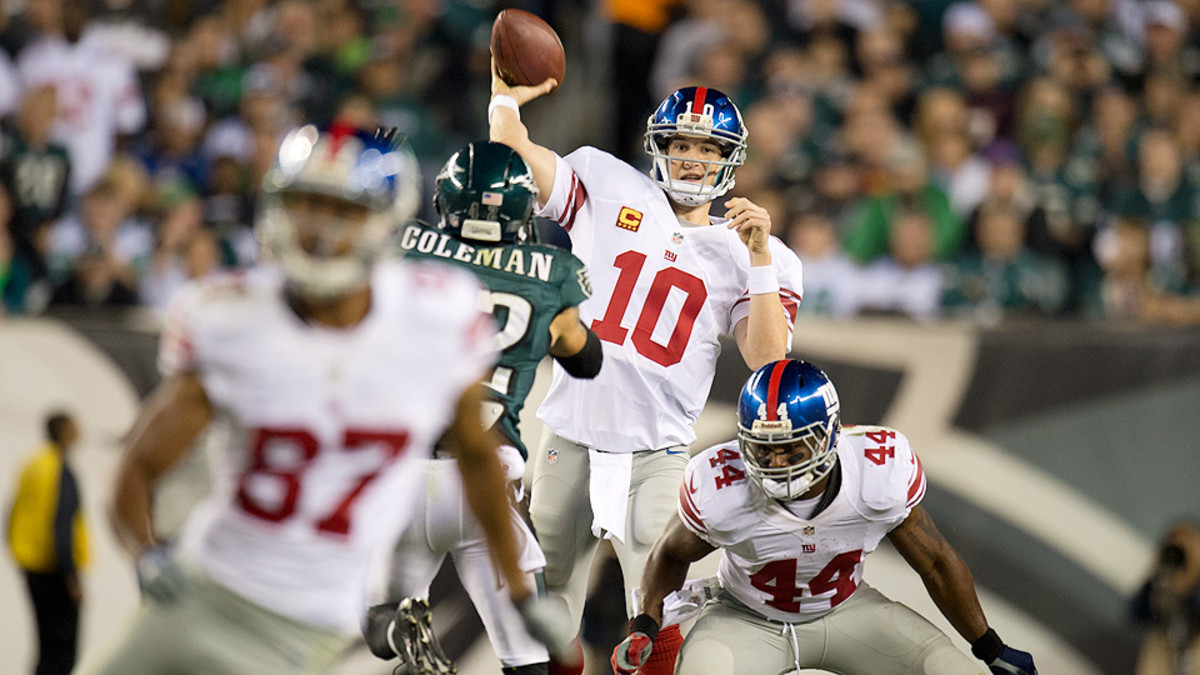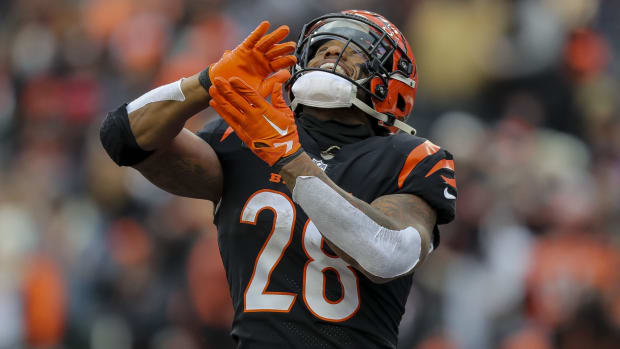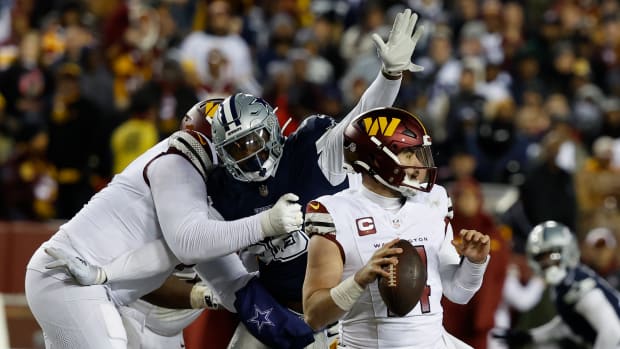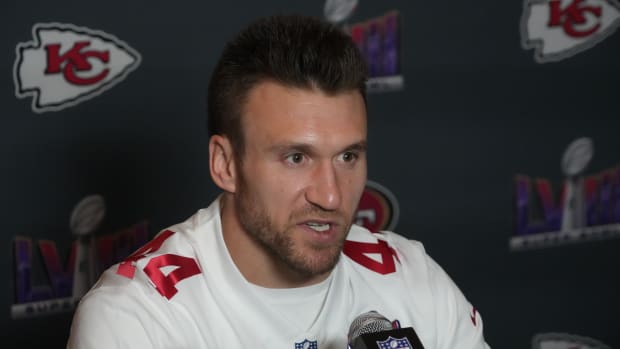
Giants hope new offense can help Eli Manning return to former glory
EAST RUTHERFORD, N.J. -- The Blueprint -- this is the Giants, after all -- is a fairly obvious one. In the NFL, when you have a 2004 first-round franchise quarterback in dire need of a career re-invention, the playbook calls for the installation of a new offense featuring a dynamic up-tempo short-passing game and the hiring of a quarterback-friendly new offensive coordinator.
That formula worked brilliantly for Philip Rivers in San Diego last season, thanks to the arrival of new Chargers head coach Mike McCoy and first-year offensive coordinator Ken Whisenhunt, which produced the Associated Press Comeback Player of the Year award for San Diego’s ninth-year veteran quarterback. So why wouldn’t a similar mid-course correction be just the right approach for the faltering game of New York’s Eli Manning, the two-time Super Bowl MVP whose name will forever be linked with Rivers thanks to their celebrated trade for one another atop the 2004 draft?
Playing the role of magic men McCoy and Whisenhunt this season, in this case on the opposite side of the NFL map, is ex-Packers quarterbacks coach Ben McAdoo, hired away from Green Bay to breathe new life into a Giants offense and give New York its first fresh approach on that side of the ball since Manning’s rookie year. The move was aimed at those who have questioned whether Manning has already turned in the best work of his 10-year career, and see continued regression rather than rejuvenation ahead for the 33-year-old Giants starter.
The Rivers example in San Diego last year looms large in the Giants’ just-begun training camp, and Manning himself sees no reason McAdoo’s presence can’t make an equally sudden impact on his game and a New York offense that had grown fairly stale and predictable under former offensive coordinator Kevin Gilbride.
“I hope we can have a similar experience [as Rivers], and a similar season where we’re being a very efficient offense, making the playoffs and getting back to where we need to be,’’ Manning told me Wednesday afternoon, just before the team’s second practice of camp at its home complex, the Quest Diagnostics Training Center. “That’s why I’m so excited. I’m excited about the new offense and about working with Coach McAdoo. I think it’s very possible to have the kind of turnaround [Rivers did].
“I can still play at a high level. It’s just a matter of being given the right circumstances and getting everyone to buy into the offense. But I think change is going to be good, just to bring up the tempo, the urgency and kind of re-energize everybody.’’
The words re-energized, rejuvenated and reinvigorated are being tossed around by nearly everyone on offense in Giants camp, where all eyes are on Manning as he attempts to rebound from the debacle that was the 2013 season, the worst of his career. Manning led the league and broke a franchise record with 27 interceptions last year, absorbing a career-worst 39 sacks (more than twice as many as 2012’s 19) with his lowest yards per attempt figure (6.9) since 2007.
The Giants offensive line caved in around him at times a year ago, and the running game all but disappeared, but Manning did his part to fuel the 7-9 disappointment in the Meadowlands, playing hesitantly, making way too many dubious decisions and developing some sloppy habits in the pocket. His 18 touchdown passes were his fewest since his rookie year of 2004 (when he started just seven games), and the season was essentially over when New York started 0-6, though a 7-3 record in the year’s final 10 games put something of a Band-aid on the worst of the problems.
But the Giants, to their credit, didn’t delude themselves into thinking the status quo was acceptable or that last year’s downturn was just a matter of that slow start. New York is known as one of the most stable and patient organizations in the NFL, but big changes were made heading into the 11th year of the Tom Coughlin-Manning era. Though Coughlin was retained and had his contract extended through 2015, Gilbride retired after 10 years on Coughlin’s staff (he was Manning’s QB coach in 2004-05, and the coordinator from ‘06-13), and was replaced by the 37-year-old McAdoo, a first-time coordinator who helped coach Green Bay to dizzying offensive output in the past eight years.
The Giants also hired ex-Oregon State OC Danny Langsdorf as their quarterback coach, upgraded their roster at running back, receiver and offensive line and overall spent more than $116 million this offseason in an attempt to reload rather than rebuild. But the key is how Manning responds to an offense that is predicated on getting the ball out quickly, making quick reads and shorter drops and finding the team’s playmakers in space, with the ability to rack up plentiful yards after the catch.
Rivers absolutely thrived in such a system last year in San Diego, leading the NFL in completion percentage (69.5), with top-five rankings in yards (4,478), touchdowns (32), passer rating (105.5) and yards per attempt (8.23). The Chargers, not coincidentally, finished 9-7 and returned to the playoffs for the first time since 2009, notching a first-round upset at Cincinnati.
And now it’s Manning’s turn to execute that kind of turnaround by embracing the first new offensive scheme he has tackled since his rookie season. If the makeover works in New York, the Giants have a great shot to end a two-year playoff drought and avoid missing the postseason three consecutive years for the first time since 1994-96, the final three years of the four-year Dan Reeves coaching era. If it doesn’t work, it could signal even more significant changes in New York, with perhaps the close of the Coughlin era and the Giants front office facing a decision on Manning, whose sizable contract ends in 2015.
If there’s a consensus so far, it’s that Manning is attacking the nuances of McAdoo’s up-tempo, force-the-issue offense as if there’s a clock ticking and no time to lose. To say he has embraced the change is a Giant-sized understatement.
“I’m overly confident in Eli Manning,’’ Giants safety and defensive team leader Antrel Rolle told me Tuesday. “He has a look on his face when he walks around the facility as if he has something to prove. He has some ass to kick and we’re going to be right there alongside of him the whole way.’’
Patrick Willis, Peyton Manning lead a stacked All-SEC NFL alumni team
Manning’s go-to receiver, Victor Cruz, said he believes he could catch 100 passes and top 1,500 yards, with at least 10 touchdowns, in the Giants’ new West Coast-style offense. Having three Giants receivers with between 60-80 receptions is plausible, Cruz said, and Manning will benefit from no longer having to take so many deep drops on downfield pass plays that were slow-developing, challenging New York’s offensive line in pass protection and leading to some of the punishment the quarterback absorbed last year.
“I think in this offense he can absolutely be that guy to come back and have a big year and get back on the radar, and get us back in the playoff hunt,’’ Cruz said. “I think it can definitely do for him what this type of offense did for [Rivers]. Every one is feeling rejuvenated on offense. You can see it. You can see he’s a different guy out there and he’s really motivated. He wants to make every throw, and if it was up to him, he’d take every rep he could. It’s good to see, because that motivates the rest of us.’’
Though the Giants won the Super Bowl roughly 29 months ago, this is clearly a team in transition. But if New York can make a quick adjustment to McAdoo’s offense, with its ability to create multiple stress tests for a defense, Manning’s passing numbers could soar. Already his confidence seems to have made a strong comeback.
“What I noticed in the spring, when he had the ankle [injury] and we were trying to be careful with him, was how he came back so quickly from that,’’ Giants general manager Jerry Reese said. “That told me this guy is serious, this guy is ready to go. He wasn’t happy sitting out. He wasn’t having it. He got out there and he was throwing the ball with so much velocity this spring. That told me he’s got that adrenaline flowing already, even in the spring. Because the ball was really coming out of his hand.
“With this offense, I’m glad that he’s challenged in a different way, and learning a new system. I think that rejuvenates him a little bit. The guy’s a self-motivator. He understands what happened last year. Everybody talks about the offensive line, but he knows a lot of those interceptions were on him as well. He’s a very prideful guy. I expect him to come back and have a tremendous year, and I think this offense will help him do that.’’
In Gilbride’s offense, the one that helped the Giants win Super Bowl rings in early 2008 and ‘12, the approach was more methodical and calculated, with pass plays that focused on downfield throwing. But Giants co-owner John Mara labeled that offense “broken’’ after New York finished 28th in points and yards in 2013, and that’s why Coughlin was willing to take a gamble on a young coach like McAdoo who has yet to call a play in the NFL, and who had no ties to the Giants organization or to their 67-year-old head coach.
“In this offense, the ball’s going to get out of Eli’s hand a little bit quicker and it’s going to try and dictate to the defense with the up-tempo approach,’’ Reese said. “He’s not going to have to make all the checks at the line of scrimmage, because the center is more involved with our checks. The plays aren’t as slow-developing and everybody doesn’t have to be on the same page in this offense, with the receivers having to run the right routes and looking at the defense the same way as the quarterback.
“And when you run an offense for 10 years, people start to scheme you a little bit better and have an idea of what you’re doing. So I do think this new system should help Eli a little bit and reinvigorate his game.’’
Coughlin said being too comfortable for too long had become the enemy on offense, and he likes that Manning and the rest of New York’s offense has been forced to turn the page on the past decade and start over. The Giants offense last year did nothing well enough to hang its hat on, and so forging a new identity wasn’t only in order, it was mandatory. And that starts with Manning, two Super Bowl MVP awards and all.
“I see the excitement and the real intense interest again from him,’’ Coughlin said. “Eli has always been a great student, but he’s really into his study, his new terminology and asking a lot of questions about the offense. This change wouldn’t have necessarily had to happen had we played better and accomplished more last year, but we just didn’t perform.
“The idea was that I felt we needed a new energy, we needed a rejuvenation, we needed a new stimulation. I wanted players who weren’t comfortable and didn’t know what was coming next.’’
If Rivers’ career resurrection in San Diego last season really is the same path Manning follows this year in McAdoo’s offense, the Giants actually will have a pretty good idea of what’s coming next: A return to relevance, for both the franchise and its comeback-minded franchise quarterback.




































